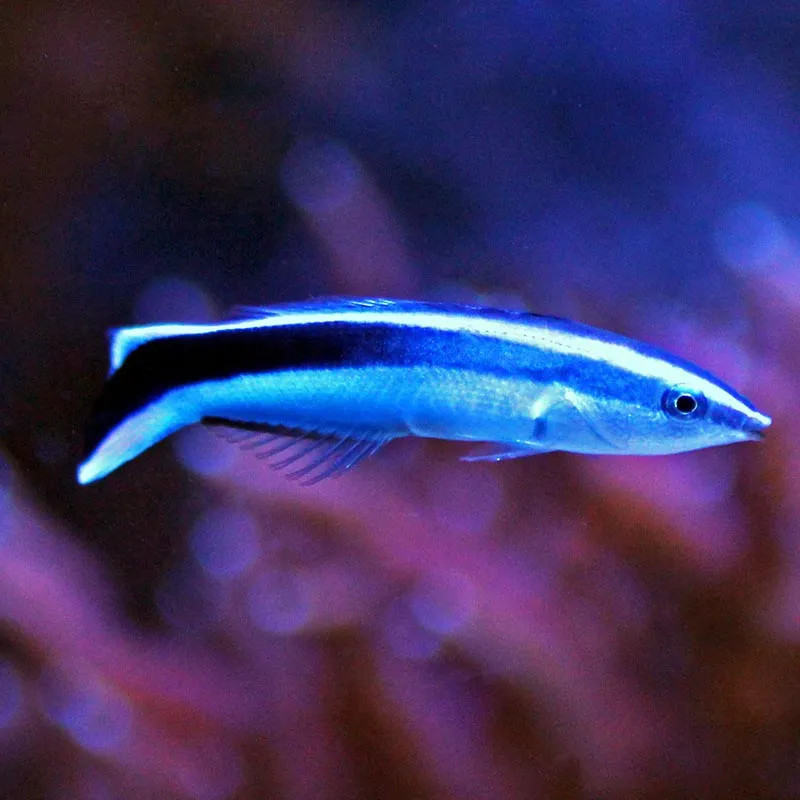Stocks Available
Exquisite Fairy Wrasse M
SKU:227151
Cirrhilabrus exquisitus
2-3 INCH

Stock Available
Introduction: • Species: Cleaner Wrasse • Common Names: Cleaner Wrasse, Blue Streak Cleaner Wrasse, Common Cleaner Wrasse • Natural Habitat: Found in coral reefs and lagoons of the Indo-Pacific, the Red Sea, and Indian Ocean. Known for their symbiotic relationship with larger fish, providing cleaning services by eating parasites and dead skin. Physical Characteristics: • Appearance: Slender, elongated body with a distinct black horizontal stripe running from the mouth to the tail, set against a bright blue or yellowish body. • Size: Grows up to 5 inches (13 cm) in length. • Lifespan: Typically lives 2-4 years in the wild but may have a shorter lifespan in captivity due to feeding and environmental challenges. Habitat Requirements: • Tank Size: A minimum of 55 gallons, but larger tanks are recommended for community setups with other reef fish. • Water Conditions: o Temperature: 75-82°F (24-28°C). o pH: 8.1-8.4. o Salinity: 1.020-1.025 specific gravity. • Aquascaping: Provide ample live rock and reef structures, which mimic their natural environment and offer places for hiding and foraging. Diet: • Primary Diet: In the wild, they feed on parasites, dead skin, and mucus from larger fish. • Supplemental Feeding: In captivity, feeding can be challenging. They may accept frozen or live brine shrimp, mysis shrimp, and specialized marine food. • Feeding Frequency: Feed several times daily, as they are constant grazers in the wild. Compatibility: • Temperament: Peaceful and non-aggressive. Known for forming cleaning stations where they interact with other fish species to remove parasites. • Suitable Tank Mates: Ideal tank mates include larger, peaceful reef fish that can benefit from their cleaning services, such as tangs, angelfish, and groupers. • Incompatibilities: Avoid highly aggressive fish or small, delicate species that may stress the wrasse. Care Level: • Difficulty: Difficult; they are often challenging to feed in captivity and require a stable, well-established reef tank. • Health Monitoring: Monitor for signs of malnutrition or stress due to their specific dietary needs. Ensure proper water quality and avoid keeping them in tanks with heavy competition for food. Breeding: • Breeding in Captivity: Rarely bred in home aquariums. They are sequential hermaphrodites, starting as females and potentially becoming males if needed for reproduction in a group setting. • Spawning: Typically involves a display of courtship and the release of eggs into the water column for external fertilization. Economic Considerations: • Market Demand: Highly sought after for their unique behavior and cleaning abilities in reef tanks. • Pricing: Priced moderately, though their challenging care requirements may influence long-term costs. Sustainability and Conservation: • Wild Population: Considered stable, but concerns have been raised about overcollection for the aquarium trade. Wild-caught specimens may suffer high mortality rates in captivity. • Aquaculture Efforts: Limited success in captive breeding and aquaculture, with most individuals in the trade still wild-caught. • Conservation: Efforts should be made to source captive-bred individuals when possible, and careful consideration should be given to their care requirements before purchase. Conclusion: The Cleaner Wrasse is a fascinating fish known for its mutualistic relationship with other marine species. However, its challenging feeding habits and specific care needs make it suitable for experienced marine aquarists. With the right environment and proper feeding practices, they can thrive in a home aquarium and contribute to the health of other fish by keeping parasites at bay.
Data sheet
16 other products in the same category:
Customers who bought this product also bought: